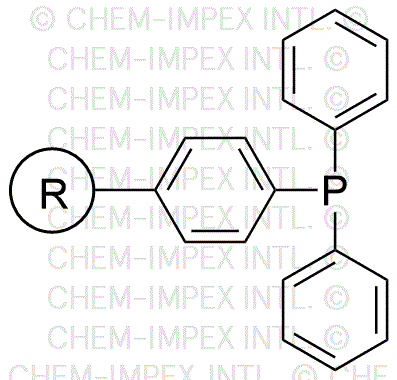Triphenylphosphine resin is widely utilized in research focused on:
- Organic Synthesis: This resin serves as a versatile reagent for the synthesis of various organic compounds, facilitating reactions such as phosphine-catalyzed transformations, which are essential in creating complex molecules.
- Separation Techniques: In chromatography, it acts as a stationary phase, allowing for the effective separation of compounds based on their chemical properties, which is crucial in both analytical and preparative chemistry.
- Pharmaceutical Development: The resin is employed in drug discovery processes, particularly in the solid-phase synthesis of peptides and other bioactive molecules, streamlining the development of new therapeutics.
- Environmental Applications: It is used in the removal of heavy metals from wastewater, showcasing its ability to bind and extract toxic substances, thus contributing to environmental remediation efforts.
- Catalysis: Triphenylphosphine resin is an effective catalyst in various chemical reactions, enhancing reaction rates and selectivity, which is particularly beneficial in industrial processes where efficiency is key.
General Information
Properties
Safety and Regulations
Applications
Triphenylphosphine resin is widely utilized in research focused on:
- Organic Synthesis: This resin serves as a versatile reagent for the synthesis of various organic compounds, facilitating reactions such as phosphine-catalyzed transformations, which are essential in creating complex molecules.
- Separation Techniques: In chromatography, it acts as a stationary phase, allowing for the effective separation of compounds based on their chemical properties, which is crucial in both analytical and preparative chemistry.
- Pharmaceutical Development: The resin is employed in drug discovery processes, particularly in the solid-phase synthesis of peptides and other bioactive molecules, streamlining the development of new therapeutics.
- Environmental Applications: It is used in the removal of heavy metals from wastewater, showcasing its ability to bind and extract toxic substances, thus contributing to environmental remediation efforts.
- Catalysis: Triphenylphosphine resin is an effective catalyst in various chemical reactions, enhancing reaction rates and selectivity, which is particularly beneficial in industrial processes where efficiency is key.
Documents
Safety Data Sheets (SDS)
The SDS provides comprehensive safety information on handling, storage, and disposal of the product.
Product Specification (PS)
The PS provides a comprehensive breakdown of the product’s properties, including chemical composition, physical state, purity, and storage requirements. It also details acceptable quality ranges and the product's intended applications.
Certificates of Analysis (COA)
Search for Certificates of Analysis (COA) by entering the products Lot Number. Lot and Batch Numbers can be found on a product’s label following the words ‘Lot’ or ‘Batch’.
*Catalog Number
*Lot Number
Certificates Of Origin (COO)
This COO confirms the country where the product was manufactured, and also details the materials and components used in it and whether it is derived from natural, synthetic, or other specific sources. This certificate may be required for customs, trade, and regulatory compliance.
*Catalog Number
*Lot Number
Safety Data Sheets (SDS)
The SDS provides comprehensive safety information on handling, storage, and disposal of the product.
DownloadProduct Specification (PS)
The PS provides a comprehensive breakdown of the product’s properties, including chemical composition, physical state, purity, and storage requirements. It also details acceptable quality ranges and the product's intended applications.
DownloadCertificates of Analysis (COA)
Search for Certificates of Analysis (COA) by entering the products Lot Number. Lot and Batch Numbers can be found on a product’s label following the words ‘Lot’ or ‘Batch’.
*Catalog Number
*Lot Number
Certificates Of Origin (COO)
This COO confirms the country where the product was manufactured, and also details the materials and components used in it and whether it is derived from natural, synthetic, or other specific sources. This certificate may be required for customs, trade, and regulatory compliance.


